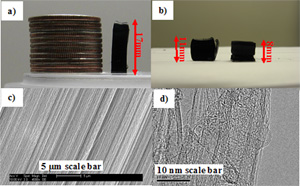Apr 26 2007

University of Cincinnati researchers lead the world in the synthesis of extremely long aligned carbon nanotube arrays; research has implications for medical, aerospace, electronic and other applications.
UC engineering researchers have developed a novel composite catalyst and optimal synthesis conditions for oriented growth of multi-wall CNT arrays. And right now they lead the world in synthesis of extremely long aligned carbon nanotube arrays.
UC's carbon nanotube arrays stack up.
Carbon nanotubes (CNTs) are of great interest because of their outstanding mechanical, electrical and optical properties. Intense research has been undertaken to synthesize long aligned CNTs because of their potential applications in nanomedicine, aerospace, electronics and many other areas.
Especially important is that long CNT arrays can be spun into fibers that are ? in theory ? significantly stronger and lighter than any existing fibers and are electrically conductive. Nanotube fibers are expected to engender revolutionary advances in the development of lightweight, high-strength materials and could potentially replace copper wire.
Carbon nanotube arrays can also be grown in intricate patterns using metal masks. The figure above shows a CNT array image of the American flag.
Years of effort by UC researchers Vesselin Shanov and Mark Schulz, co-directors of the University of Cincinnati Smart Materials Nanotechnology Laboratory, along with Yun YeoHeung and students, led to the invention of the method for growing long nanotube arrays. Employing this invention, the UC researchers (in conjunction with First Nano, a division of CVD Equipment Corporation of Ronkonkoma, New York) have produced extremely long CNT arrays (18 mm) on their EasyTube System using a Chemical Vapor Deposition (CVD) process.
Moreover, in a re-growth experiment on a separate substrate, they produced an 11-mm long CNT array. This array was then successfully peeled completely off the substrate. Without additional processing, the same substrate was reused for a successive growth that yielded an 8-mm-long CNT array.
The photographs in figures "c" and "d," above, are scanning electron microscopy (SEM) and high-resolution transmission electron microscopy (HRTEM) images of the multi-wall CNT arrays.
Shanov notes that their research has had four major milestones this year already.
"First, we were able to grow the arrays up to 18 mm," he says, ticking off the achievements. "Second, we produced a uniform carpet of 12-mm carbon nanotube arrays on a 4-inch wafer, which moves the invention into the field of scaled-up manufacturing for industrial application. Third, we filed a patent application on the inventions at the US Patent and Trademark Office and, fourth, we were invited to participate in a very prestigious workshop (invitation-only) organized by NASA and Rice University, where we presented our latest results. The workshop focused on "Single Wall Carbon Nanotube Nucleation and Growth Mechanisms." This event was attended by the best scientists in the world working on synthesis carbon nanotubes, from Japan, China, Europe and the United States. Our presentation was accepted very well and confirmed that with the current record of 18-mm-long carbon nanotube arrays, and also with the big area growth on 4-inch wafers, we are leading in manufacturing extremely long CNT arrays."
The Fine Print and Nano Details
The UC substrate for growing CNT arrays is a multilayered structure with a sophisticated design in which a metal based catalyst alloy is formed on top of an oxidized silicon wafer. Its manufacturing requires a "clean room" environment and thin-film deposition techniques that can be scaled up to produce commercial quantities. CNT synthesis is carried out in a hydrogen/hydrocarbon/water/argon environment at 750 degrees Celsius. The achievement of growing centimeter-long nanotube arrays provides hope that continuous growth of CNTs in the meter length range is possible. Leonard Rosenbaum, president and CEO of CVD Equipment Corporation, is looking forward to continuing the partnership with UC to bring this technology from the laboratory into full-scale production. UC is also partnering with another company to develop production of long CNT arrays that can be spun into fibers.